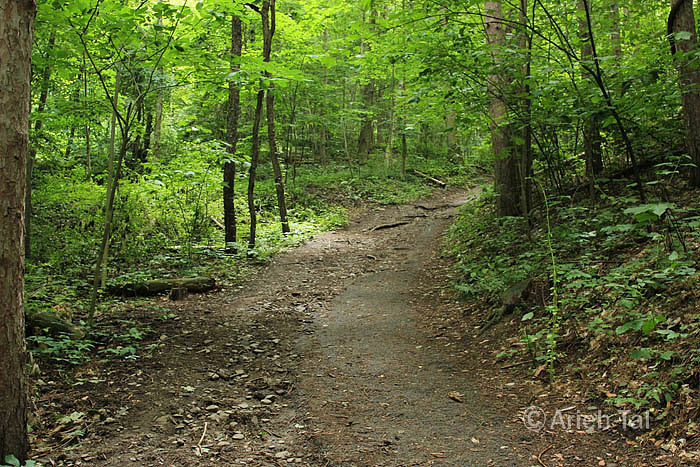|
|
||
| x Figure A. View of the lower subsection of the rim trail. July 2021. |
|
. |
||||
| . . |
Home | Ecology Main | Documentation | . |
| .Plant
Ecology of the Area Surveyed Lower Rim Trail |
||||
|
|
||
| x Figure A. View of the lower subsection of the rim trail. July 2021. |
| The
lowest subsection of the rim trail is so named because it is located at
or near the base of South Hill. It is closer to the main parking
lot and visitor center than to the gorge. The trail surface is
unimproved: rough, well-worn and uneven, with a few portions covered
with aging asphalt. The few stairs that are in place
probably date back to the creation of the state park in the 1920s.
For hikers, the ascent is continuous from the trail head at the parking
lot, up to the small, western overlook over the gorge.
Because it is at the base of a hill, it receives ample moisture for most of the year; moisture that supports lush vegetation. Plant communities tend to be dense, and competition between plants for essential resources can be daunting. Aggressive and invasive vines and shrubs abound, such as oriental bittersweet,* border privet, Japanese barberry, riverbank grape and Virginia creeper. Tree diversity is high. Thirty-one species of trees were identified in this subsection of the rim trail. This mixed forest consists mostly of native hardwoods and a scattered white pines. A large red pine plantation, part way up the slope, bears witness to logging activities ages ago. Tree ages are variable, many evidently very mature, but many others fairly young. Understory trees include hop hornbeam*, hackberry, musclewood and striped maple. Witch hazel, maple-leaved viburnum, chokecherry, pagoda (alternate-leaved) dogwood, border privet and Japanese barberry are among the more common shrubs. This portion of the rim trail is rich in common ferns, such as Christmas fern,* marginal woodfern, intermediate woodfern, lady fern and sensitive fern. A medium-size colony of ostrich fern can also be found near the junction with the campground road. Wildflowers are also abundant. These herbaceous, flowering
species include blue cohosh,*
may apple, Virginia waterleaf, sweet cicely, false Solomon-seal, red
baneberry, white baneberry, thimbleweed, pointed-leaved tick-trefoil,
partridgeberry, kidney-leaved buttercup, hooked buttercup, zigzag
goldenrod, wild geranium, sanicles, jumpseed and lopseed. |
|
 |
|
Figure B. Stretch of the the
lower rim trail close to the red pine plantation, July 2021. x |
| The
lower rim trail is similar to the middle rim trail with respect to
available moisture and density of tree canopy.
Yet, the overall appearance is noticeably different. Understory
vegetation in the lower rim trail appears thicker, perhaps even chaotic,
by comparison with that of the middle rim trail. There are many
more younger trees here than in the middle rim trail, and there are more
shrubs as well, many of those, unfortunately, are privets and
barberries.
It's also worth mentioning that most of the non-native species here are woody species: shrubs or vines. Weedy plants of open, disturbed spaces are practically unknown here in the much darker habitat. |
||
|
|
||
| Figure B. Sampling of understory vegetation (shrubs, vines, ferns & young trees) along the lower rim trail, July 2021. | ||
|
* To convert English plant names to their scientific equivalents, click this link. |
.
|
. |
.